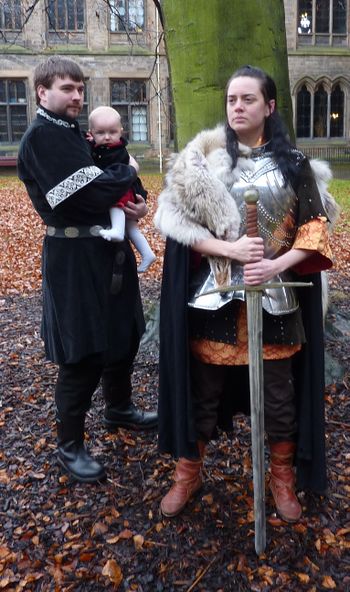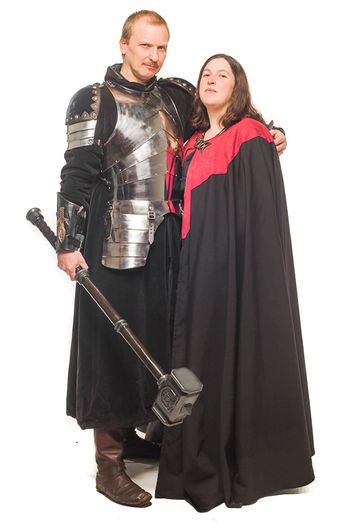Marriage in Dawn
No edit summary |
No edit summary |
||
| Line 1: | Line 1: | ||
{{stub}} | |||
{{CaptionedImage|file=Dawn1.jpg|align=left|width=350|caption=A Dawnis [[earl]], her husband, and their child.}} | {{CaptionedImage|file=Dawn1.jpg|align=left|width=350|caption=A Dawnis [[earl]], her husband, and their child.}} | ||
Between [[Yeomen of Dawn|yeomen]], marriage is generally a matter of two individuals going before a noble and asking them to bless their union. All nobles have the right to bless a marriage, and in Dawn it is considered to have the same weight as a binding contract elsewhere. Both spouses must consent to the union verbally three times before two witnesses, but nothing else is required. A third witness, in the form of a troubadour, is often included as a matter of course but is not required, and while the troubadour may perform a religious ceremony after the wedding they are not involved in the actual union. | Between [[Yeomen of Dawn|yeomen]], marriage is generally a matter of two individuals going before a noble and asking them to bless their union. All nobles have the right to bless a marriage, and in Dawn it is considered to have the same weight as a binding contract elsewhere. Both spouses must consent to the union verbally three times before two witnesses, but nothing else is required. A third witness, in the form of a troubadour, is often included as a matter of course but is not required, and while the troubadour may perform a religious ceremony after the wedding they are not involved in the actual union. | ||
Revision as of 14:42, 27 October 2017

Between yeomen, marriage is generally a matter of two individuals going before a noble and asking them to bless their union. All nobles have the right to bless a marriage, and in Dawn it is considered to have the same weight as a binding contract elsewhere. Both spouses must consent to the union verbally three times before two witnesses, but nothing else is required. A third witness, in the form of a troubadour, is often included as a matter of course but is not required, and while the troubadour may perform a religious ceremony after the wedding they are not involved in the actual union.
Things are not so simple when nobles marry, even assuming the suitor can pass the Test of Ardour.
Because of the unusual nature of a Dawn noble house, it is possible and legal for siblings or other close relations to marry. Such unions are legal, but the lovers are expected to remain chaste, even if they share the same gender, to avoid scandal. Those who do are usually rewarded with children from other houses to adopt, while those who don't are shunned and any children they have are often set impossible tests.
Perversely it is not legal for members of the same house to marry, regardless of how they joined the house. This seems strange to outsiders but the Dawnish believe that the house is the family, that the relationship with an adopted brother or sister is as important as that with a biological sibling. For a house to openly treat nobles who were born into the house differently to nobles who have joined the house brings shame to all.
Because of the legal prohibition preventing marriage between members of a house, those who fall in love have few options. They can elope and leave Dawn or else adopt a chaste relationship. Courting and public displays of affection, appropriate for any inhabitant of Dawn are allowed, but nothing more. Illegitimate children bring shame on both parents equally - they are never permitted to join their mother's house and are usually adopted by a loyal yeoman.

In theory a noble may marry a yeoman, but the yeoman is not ennobled by the marriage and such unions are rare and difficult as a result. Dalliances between the nobility and yeomanry are frowned upon; it is beneath the status of a noble to love one who has not proved themself. Tales of yeomen inspired by love to pass the Test of Mettle are a common legend however.
Because of the restrictions, lovers who wish to wed must be members of different houses. Young lovers who have not yet taken their Test of Mettle must request a test from different houses to ensure this and then complete the Test of Ardour. This is considered wise by most Dawnish nobles - it prevents one of the parties completing their test and then pressurizing their Earl to set too easy a Test of Mettle for their paramour. Their intended must pass a test set by another Earl, ensuring that their nobility is fully proven.
If two members of the same house fall in love the only way they can marry is for one to seek a Test of Mettle from another house. Traditionally a second Test of Mettle for a noble who has been thrown out of their house is impossibly difficult, but those whose requests are known to be motivated by love are sometimes not noticeably more difficult than a normal test. The Dawnish nobility well understand the affairs of the heart and do not punish people for seeking happiness. Of course the applicant must still pass a second Test of Mettle and then one of the two must complete a Test of Ardour. And if they are biologically related, their marriage must remain chaste, regardless of gender. Such is the life of a Dawnish noble.
Divorce is not officially recognized in Dawn. Two individuals may separate, but they remain members of the same noble house and no other noble house can accept a Test of Ardour from a Dawn noble while their spouse still lives. The nobility of Dawn demand adherence to the highest ideals of nobility; those who want a simple life of pleasantries should remain yeomen.